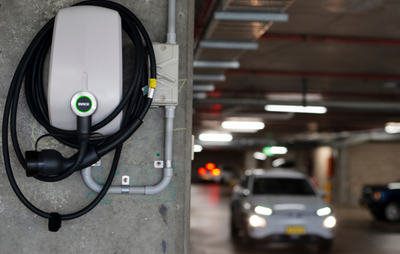We have created this tool to help you understand the cost of retrofitting electric vehicle (EV) infrastructure in your building. Its aim is to help you understand not only the cost of the charging equipment, but also the related infrastructure upgrades that may be necessary.
While the assumptions used in the tool are based on industry best practises and have been peered reviewed by industry stakeholders, it is to be used as a guide only.
What to do before using the EV charging infrastructure cost tool
This tool assumes some prior technical knowledge regarding terminology and infrastructure requirements. If you need more information about what is required knowledge before using this tool please look at our EV ready buildings web pages and terms below.
Before you start, please ensure you have site specific information and measurements for the following:
- carpark floor plans
- number of carpark spaces in your building
- trenching requirements (metres)
- cable trays required (metres)
- sub-mains required (metres)
- final circuits required (metres)
EV charging overview
Upgrades to existing switchboards
This will depend mostly on the available spare capacity of the switchboard, as well as its age. It is often the case in older buildings that a switchboard is not up to current code and any modifications require it to be upgraded to comply.
Trenching costs
If trenching is required, the cost depends on latent conditions such as soil type and whether there is hard rock.
Cable supports and routing
The ability to install cable trays or conduits that support cable runs can vary in difficulty based on obstructions from other equipment, how they can be mounted and how far the car spaces are from switchboards.
Upstream upgrades
The availability of capacity in grid infrastructure supplying the site, such as cable feeders and distribution transformers, like heating, ventilation and air conditioning, varies significantly from site to site. This is largely to do with how electricity is consumed by other consumers in the area and the age of the equipment. If capacity is constrained, the distribution network service provider (DNSP) may charge for costs to upgrade this infrastructure and these costs can be substantial. The best way to find out if capacity is available is to lodge a preliminary inquiry with the DNSP with an estimate of the additional electrical load that will be connected. In NSW the three DNSPs are Ausgrid, Endeavour Energy and Essential Energy.
Communications infrastructure
load management systems are highly recommended for building retrofits. These systems monitor the amount of power that EV charges are consuming and can help manage the load below infrastructure limits, while still meeting the charging needs of vehicles. Charging is spread more evenly across longer durations, such as overnight and utilised spare capacity when it is available. In order for a load management system to operate it needs communications cables such as Ethernet to be connected to each charger and wired back to a central control box.
Ongoing costs
Other considerations include how electricity cost is to be recovered for EV charging, if charges are public or private, the building is part of an Embedded Energy Network and what level of monitoring is required. An ongoing subscription for such services may be required from a suitable chargepoint operator.
Dedicated individual verse public or shared charging
Dedicated or individual charges are typically provided to a consistent or known user of an EV parking bay. In residential buildings this would be an owner occupier or tenant with a dedicated car space, and in commercial this may be an employee or employees. These are usually slower or low rating charges, as vehicles are parked for longer periods and therefore have more time to charge.
Main switchboard (MSB)
A main switchboard is the central point of connexion between the site and the grid. Power is distributed from here to other parts of the site.
Distribution boards (DBs)
distribution boards are connected electrically to the MSB via larger higher capacity cables. From he power is distributed to power points, lighting and appliances. The reason for this is to avoid large quantities of cable runs from the MSB to all the palate consumers within a building and use backbone infrastructure, which then splits into smaller sub circuits.
Communications panels (CPs)
These are small cabinets that contain communications equipment such as routers. They enable charges to be connected to a control system and communicate using standard network cabling such as Ethernet. They enable a similar typology to MSBs and DBs, minimising cabling.
Sub-mains
These are the higher capacity cables between MSBs and DBs.
Final circuits
These are the smaller cables from DBs to appliances like EV charges.
Trenching
Trenching is often used in open air car parks to instal cabling underground between various infrastructure. Excavation and resurfacing is required when retrofitting cabling in this manner.
Cable trays
Cable trays are supports that are fixed to ceilings or walls and used to secure cable runs between electrical infrastructure.
